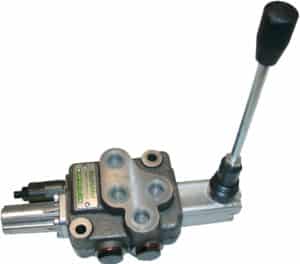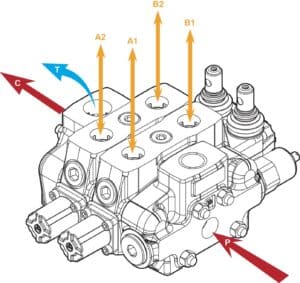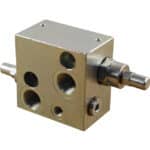In the field of mobile machinery, there are special requirements for valve technology. Control blocks for mobile applications have significant differences to hydraulic valves in stationary use.
Content
Mobile control block - monobloc valve
Monobloc valves are mobile control blocks in which the oil ducts are mainly integrated or cast into the control block. The spools move directly inside the valve block. The piston actuators are mounted from the outside, built-in cartridges extend the control functions.
The integrated channels offer particularly favorable flow characteristics, and the external shape adapted to the casting process results overall in a very material- and space-saving design.
Such a design is feasible due to the high quantities of identical control blocks used in mobile applications.
Mobile directional control valves in monobloc design are usually available with up to 6 individual sections.

What are pulling loads in hydraulics?
In order to achieve greater flexibility with lower quantities, mobile control blocks are also “broken down” into individual valve slices. By individually assembling several such discs, depending on the application requirements, a control block in sandwich design is created. Sectional valves are also mobile control blocks and an important component of oil hydraulic systems used in many mobile machines. They enable the movement and control of hydraulic cylinders and hydraulic motors.
In oil hydraulics, sectional valves are also known as directional valve manif olds. They consist of multiple valve sections connected in series that can be individually actuated to control hydraulic oil flow and pressure.
Hydraulic lowering brake valves are safety valves
Sectional valves consist of individual valve sections that are strung together. Such a block consists essentially of:
- Connection plate
The inlet P and the return R take place via these. It contains a pressure relief valve or other valve functions. - Valve sections
Up to 8 segments can be connected to each other in a sandwich construction. These include valve functions for consumer ports A and B and are available in different design variants. The directional control valve segments are used to control the direction as well as the precise speed control of cylinders and hydraulic motors. To meet these requirements, the directional control valves are equipped with fine control edges. The spool travels and thus the overall lengths are longer than with pure switching valves. - End plate
It forms the end of the valve block and usually does not contain any active elements. - Tie rod
The valve block is held together via these.
Sealing between the individual segments is provided by O-rings on the flange surfaces. Sectional valves can be manually, electrically, pneumatically or hydraulically operated, depending on the requirements of the application. Electric controls typically offer greater precision and flexibility, while manual controls can be simpler and less expensive.

A potential problem with sectional valves is the internal leakage that can occur when the pressure between the valve sections is uneven. This often places high manufacturing demands on the sealing surfaces. To minimize this problem, special seals and gaps are often used.
Lowering brake valves for hydraulic cylinders
Monobloc valve
- Cost-effective
- Very compact
- max. 6 sections
- Little flexibility, sections not needed must be “closed”.
- Maximum flow rate lower compared to sectional valves
Sectional valve
- max. 8 sections
- Flexible: a wide range of functions can be integrated, sections that are not required can be removed.
- High flow rates feasiblecontrol
- Susceptible to leakage
Less compact
Directly buy mobile control blocks in our store
In our hydraulic store you will find a wide range of mobile control blocks.
- Mobile control block - 13. May 2023
- Hydraulics lowering brake valves - 6. May 2023
- axial piston engines - 2. May 2023
